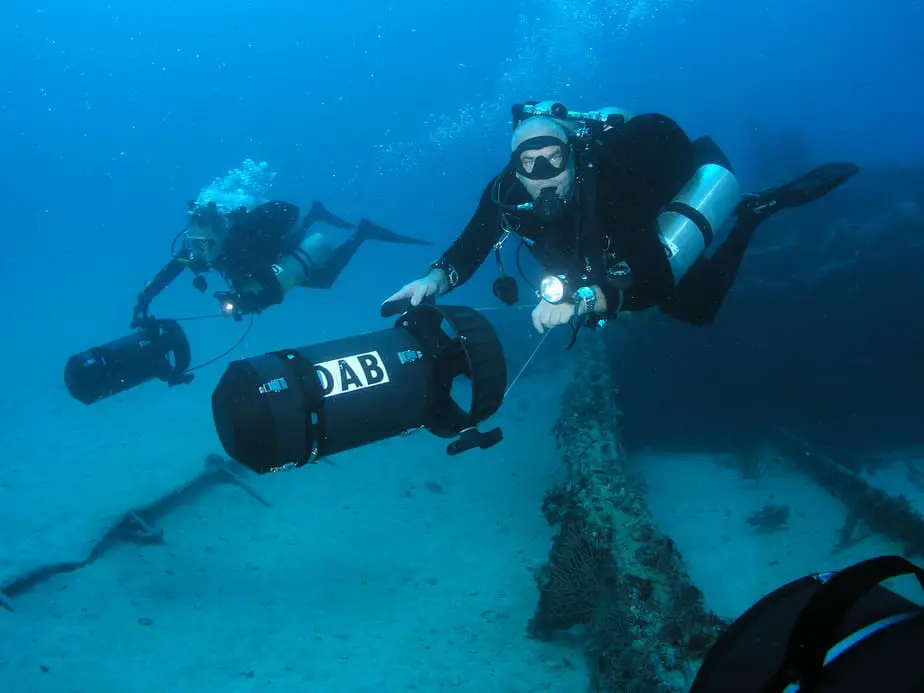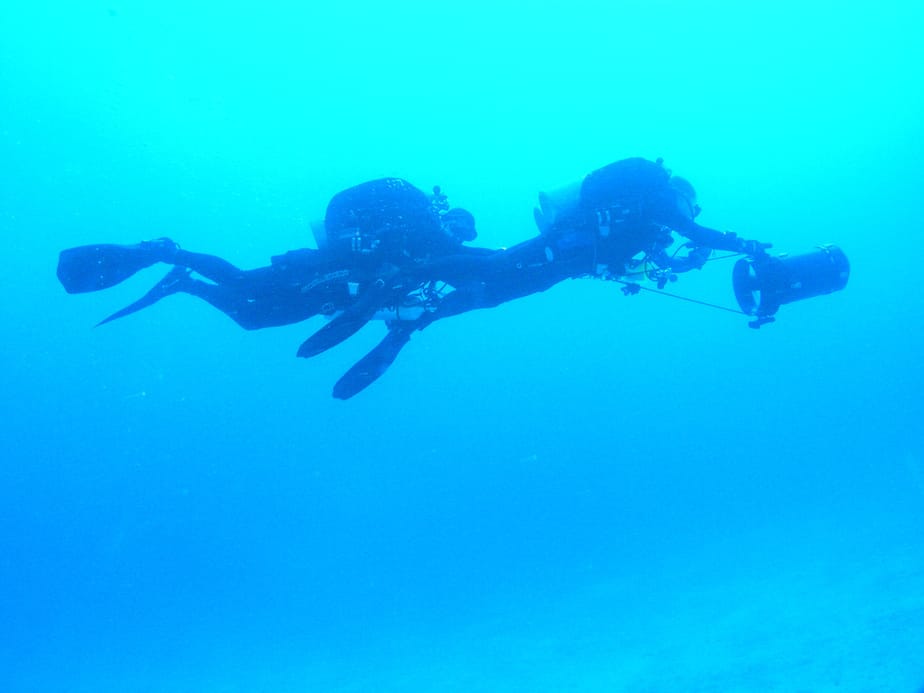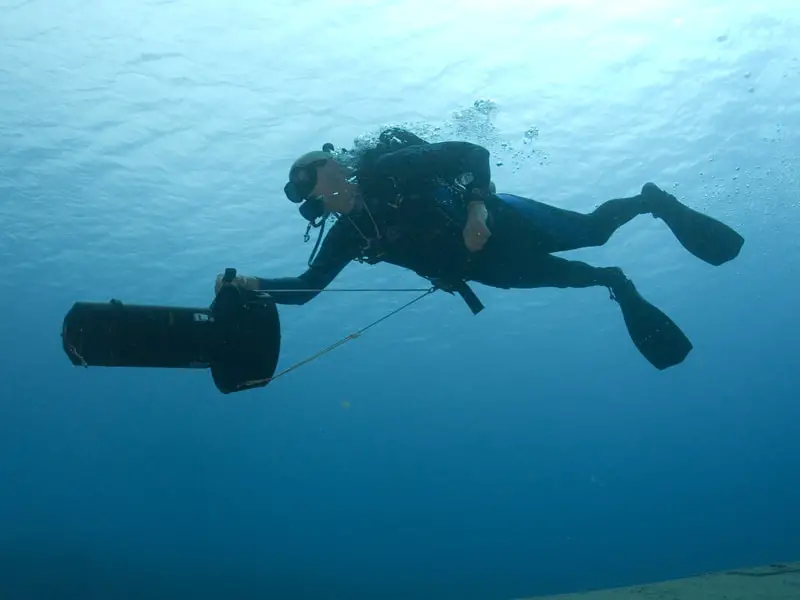Diver propulsion vehicles (DPV) or underwater scooters are equipment that can take your snorkeling or scuba diving experience to the next level. Have you ever wanted to jet through the water like a torpedo? Or zoom across it like a boat? DPVs are a technological advancement that lets you do these things so that you can experience the thrill of being as fast as a shark underwater.
Not only are DPVs fun, but they are also extremely beneficial for divers and snorkelers. You can cover large distances in a short period of time without exerting yourself at all. All you need to do is hold on tight to the DPV and it will do all of the heavy lifting. For scuba divers, this is an incredible boon because you can conserve energy and breathing gas. For snorkelers, you can explore more of the coral reefs while conserving energy. Read on to find out more about how a DPV can benefit you.
What exactly is an underwater scooter/DPV?
Essentially, a DPV is a machine with a waterproof housing that holds an electric motor and one or more propellers. The housing will have buttons to adjust the speed, and will also have handles for you to hold onto.
There are numerous types of underwater scooters that vary in capacity, size, and price. The most popular ones are basic models where the diver or snorkeler holds the handle and can squeeze the trigger to start up the engine.
There are numerous safety features in place because holding onto something with propellers and a motor is a cause for concern. The propeller will be covered up so that debris or your fingers can’t fit through the cover. Depending on the design, it’s possible that hair can still pass through, so tie your hair back if you have long hair. Furthermore, a good scooter should be designed so that it will not accidentally start, e.g., it may have a design that requires both triggers be held down to start.
Using a DPV, you can move faster underwater to cover larger distances and explore more of the dive site. Similarly, snorkelers can also cover more distance at the surface and reach destinations that are further out. This can help you reach new parts that you otherwise wouldn’t have been able to reach due to how long it’d tackle you. Many new dive sites have been discovered this way.
Lastly, not only is it fun to find new places to explore, it’s arguably more fun just tearing through the water at breakneck speeds that you wouldn’t have been able to achieve by kicking your fins. If you’ve ever wanted to feel what it’s like to be as fast as a fish, this is your chance. You’ll also conserve energy since you’re not the one doing the work, leaving you fresh to explore the dive site once you reach it.
History of DPV underwater scooters
Like many technological innovations, the idea for a DPV was conceived during wartime. Specifically, during WWII, underwater devices that function very similarly to modern DPVs were in use in the military. Their purpose was to get soldiers close enough to enemy ships in record time. Interestingly, DPVs then were literally made with torpedo parts, so we weren’t kidding when we said you could zoom through the water like a torpedo. Later, the devices changed their design for recreational use, but the high-end DPVs today still look like torpedoes.
Who should use an underwater scooter?

In the past, DPVs were mainly used by technical divers, mostly cave divers, so that they can reach further and deeper into the caves. Nowadays, DPVs are widely available and are often used for recreational diving as well. Underwater scooters can be used by anyone at least 12 years of age or older with a PADI Open Water certification or equivalent. If you plan on going cave or wreck diving, then you should take the PADI DPV course.
This ensures that anyone who wants to try diving with an underwater scooter at least has the basic diving skills needed to handle their buoyancy and knowledge of how to handle emergency procedures. That’s why diving with DPV scooters should only be done if you are qualified, ideally with at least a few dives under your belt.
How to get started with DPV scooters?
Unfortunately, like most scuba equipment, underwater scooters aren’t cheap. Even the most basic models will cost you a few hundred dollars. It’d be a shame to spend so much on one only to find out you don’t really like it. Thankfully, you can test if diving with a DPV is for you by going on a test dive with an instructor.
By doing a trial dive with a scooter, you can see how it is operated and what the differences are between regular diving and diving with a DPV. We are confident that the DPV will win you over after a trial dive.
Once you know you want to get started with DPV diving, the next step is to take the PDV course. What you’ll learn in this course is how to safely operate a scooter and how to plan a dive with a DPV. After completing the course, you’ll receive a certification that lets you rent any scooter basically from any dive shop in the world.
Is it worth taking a DPV course?
It is worth taking a DPV course since you almost certainly learn something new. Nowadays, it’s possible to learn a lot online, however nothing beats interacting with someone face to face and having more hands-one experience with the scooter. You’ll learn about the basics of scooter construction, pre-dive servicing, and of course, how to dive with a DPV.
Taking some practical classes with a knowledgeable instructor will give you the confidence to understand all of the theory and skills needed to safely dive with a DPV. Another benefit of taking a course is that you get to ask questions and receive personal feedback so that you know what you’re doing wrong and can nip problems at the bud before they get worse. Overall, it’s very important for your safety to take the DPV course.
Can I learn how to dive with a DPV without an instructor?
If you don’t pass the DPV course, you won’t get a certification that lets you rent DPVs from dive shops. This is however not much of an issue nowadays with how easily accessible DPVs are; you can buy one off Amazon and get it shipped to you the same day. This is very tempting for some people who just want to try learning DPV diving themselves.
We do not recommend diving with a DPV without an instructor. Underwater scooters can be dangerous if you don’t know what you’re doing. You could easily hurt yourself, other divers, or marine life. Also, when you’re having too much fun zooming around on a DPV, it’s possible that you’ll forget some basic diving rules which could lead to trouble.
For example, you could potentially ride the scooter rapidly to the surface which can lead to decompression sickness. Maybe you had too much fun and simply forgot about slowly ascending. Or maybe you just didn’t know how to operate your scooter and couldn’t turn it off. Sometimes the problem lies with not knowing how to safely operate the scooter instead of anything to do with diving.
Safety is paramount
Divers who are unprepared will be in for a surprise the first time they start the motor. Scooters are designed to go really fast. Thus, you need to master the basics of maneuvering so you don’t lose control and hurt yourself or other divers. Not only is there a risk of crashing into something, but you might risk ascending too quickly. Always be wary of your ascent rate if you are ascending with a DPV.
As part of your pre-dive check, you must also inspect your scooter. Make sure the housing is tightly secured. Flooding is always a major cause of concern with electronics while diving, and it would be really expensive to replace a scooter. Also check that its battery is full because you don’t want the fun to end too soon. Plus, you don’t want to have to lug a bulky scooter back to the surface; it should be carrying you!
Recreational or professional scooters

Underwater scooters can be broadly categorized into two types: amateur underwater scooters and professional underwater scooters.
Amateur underwater scooters are a cheap solution (by dive equipment standards) if you want to have some fun while recreational diving. Typically, the cost is in the low hundreds of dollars. The scooter will come with a plastic housing which protects the electronics inside. You must start the engine by pressing a button or trigger located on the outside. The scooter will only be active when the trigger is held down, and will stop if you release it. This is a good starting point for beginners.
Professional underwater scooters are very expensive, with prices in the several thousands of dollars. To justify their high price, they are very durable and come with numerous features. For starters, their housing is made of aluminum which is much more durable than plastic. Their battery life is also significantly better, allowing you to explore for longer. Professional scooters can also be operated entirely with one hand.
Types of DPVs
Another way to categorize DPVs is by their design which affects how they are used. As we mentioned, there are a variety of DPVs from recreational to military grade, and they can be big or small, cheap or expensive, fast or slow. Unless you’re working for a private company or the government, chances are you’ll only encounter small, recreational DPVs. Here are the DPV designs you will find:
- Manta Boards: Manta boards are named after the Manta ray because of the way they look. Manta boards are essentially just underwater sleds with no motor. They are attached to a jet ski or surface boat which will tow the board forward. Divers must grasp onto the handles and angle the board downwards to submerge it underwater.
- Diver-Tugs: The body of a diver-tug is about a third of the size of an adult male. It has handles on its bow for the diver to grasp. With this design, the diver’s legs are positioned above or parallel to the propeller. Diver-tugs are typically torpedo-shaped, though some have a more square design. The motor sits at the front of the device, with the propeller at the back. Most DPVs have a diver-tug design.
- Tow-Behinds: Tow-behind DPVs work a little differently to diver-tugs in that the diver is positioned on top of the scooter. The handles are often built on the sides or on top of the stern. This design is the most hydrodynamic because of the way the diver’s body flows in line with the scooter.
Underwater scooter brands
If you want a low cost entry-level scooter for recreational diving, then Yamaha offers a fair selection that you can browse. Some other brands that offer decent entry-level scooters are sublue, Sea Doo, Geneinno, and AQUAROBOTMAN.
If you’re interested in cave diving, then you’ll need something heavy-duty. Below you’ll find the names of several leading professional scooter manufacturers. These scooters are world-class and are used by the best technical divers and recreational divers with high standards.
Professional scooters are characterized by their high speeds, large range, and long working hours. The biggest downside is how expensive they are, which will certainly lighten your wallet. However, keep in mind that when you are doing something as dangerous as cave diving, there is no price limit for your safety. Furthermore, professional scooters will last for years if you take proper care of them. Some of the top DPV brands are: SUEX, Bonex, SubGravity, and Seacraft.
Parting words
In conclusion, DPVs are a fantastic solution to help you explore more of a dive site while conserving your energy. They are also just extremely fun to use and will help you pierce through the water like a torpedo or a shark. It’s something that you should definitely try if you have the opportunity. However, not every dive center or shop has them for you to rent, however you can purchase them online.
Diving with a DPV will introduce you to a new and exciting way to explore the underwater world. It will feel like diving is new and fresh again. You’ll be able to go to new dive sites that were too far out of your reach before. For technical divers, you can explore caverns much more quickly while conserving energy. Whether you’re a recreational diver, technical diver, or even a snorkeler, you can benefit from using an underwater scooter.
Photo Credits:

